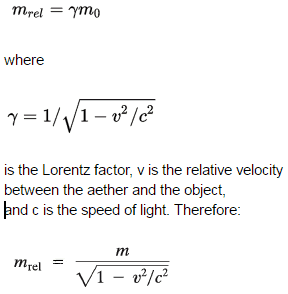While the mass is normally considered an unchanging property of an object at speeds approaching the speed of light, one must consider the increase in the relativistic mass. The relativistic definition of momentum is sometimes interpreted as an increase in the mass of an object. In this interpretation, a particle can have a relativistic mass, mrel. The increase in effective mass with speed is given by the expression:
In this “mass-increase” formula, m is referred to as the rest mass of the object. It follows from this formula that an object with a nonzero rest mass cannot travel at the speed of light. As the object approaches the speed of light, the object’s momentum increase without bound. On the other hand, when the relative velocity is zero, the Lorentz factor equals 1, and the relativistic mass is reduced to the rest mass. With this interpretation, the mass of an object appears to increase as its speed increases. It must be added, many physicists believe an object has only one mass (its rest mass) and that it is only the momentum that increases with speed.
